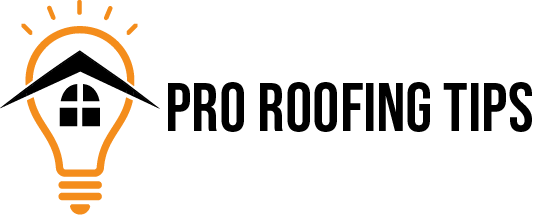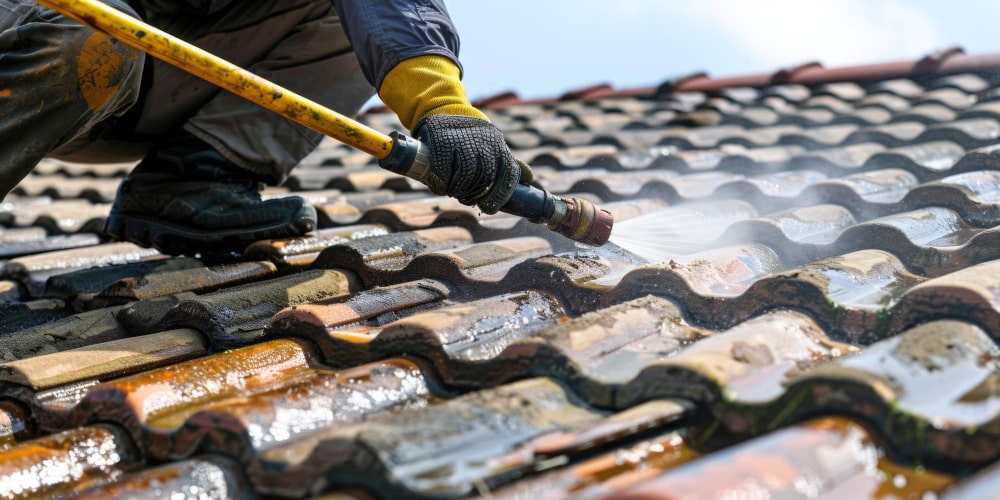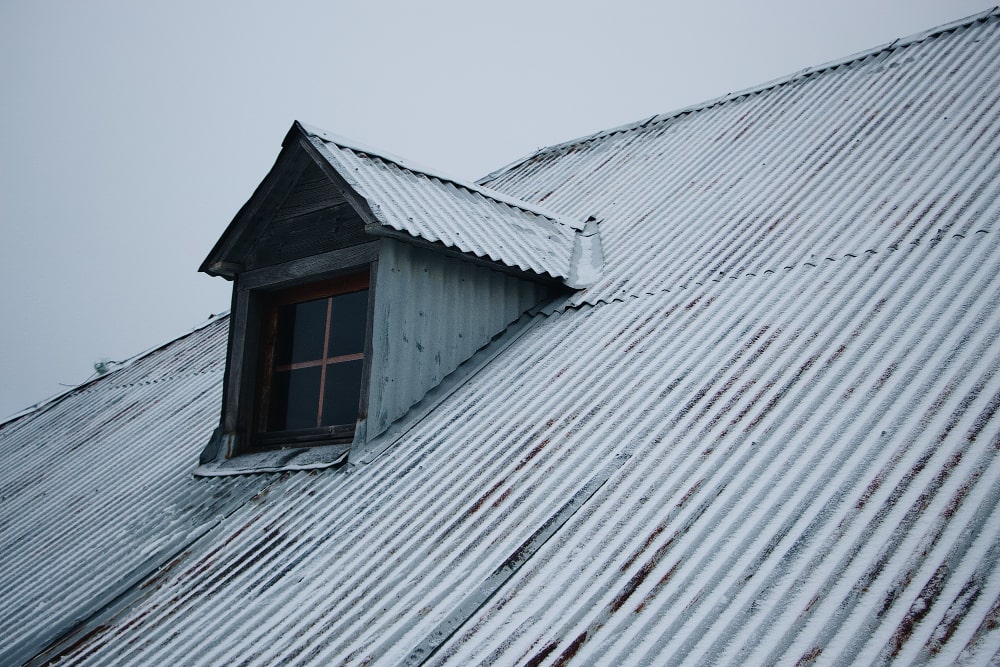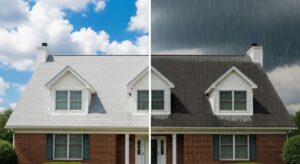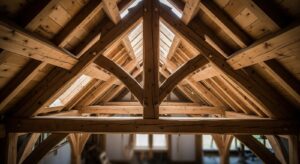If you’ve ever glanced up at your roof and noticed black streaks, green moss, or crusty patches, you’re not alone—and you’re definitely not doomed. Many homeowners deal with unsightly roof stains that make even the most well-kept home look neglected. But here’s the good news: with the right roof cleaning chemicals, you can restore your roof’s original beauty and even extend its lifespan.
Whether you’re trying to get rid of black algae, green moss, mildew, or lichen, this comprehensive guide will walk you through the best roof cleaning products, how to use them safely, and when to DIY versus hire a pro. We’ll also help you match the best roof cleaner to your specific material—be it asphalt shingles, tile, metal, rubber, or wood shake.
Let’s dive in.
Why Roof Cleaning Matters More Than You Think
Your roof takes a beating year-round—rain, sun, snow, organic debris, and pollution all play a part in degrading its surface. Without routine care, what starts as a cosmetic issue (stains, moss) can quickly become structural: water damage, lifted shingles, mold in the attic, and even premature roof replacement.
Regular cleaning with safe and effective roof cleaning chemicals can:
-
Increase curb appeal and home value
-
Prevent algae and moss from damaging shingles
-
Improve energy efficiency by removing dark heat-absorbing stains
-
Extend the life of your roof by 5 to 10 years
Want more strategies to extend your roof’s life? Visit our guide on roof preservation for pro tips and seasonal maintenance advice.
What Causes Roof Stains?
Understanding what’s growing on your roof helps you choose the right roof cleaner.
1. Algae (Gloeocapsa Magma)
These black streaks are caused by airborne algae feeding on the limestone filler in asphalt shingles. While they’re mostly cosmetic, they trap moisture, encouraging moss and mildew growth.
2. Moss
This green, sponge-like growth thrives in damp, shaded areas. Moss can lift shingles and tiles, allowing water to seep underneath and cause rot.
3. Lichen
Lichen is a combination of algae and fungus. It adheres tightly to surfaces and is particularly hard to remove. It needs a powerful roof shingle algae cleaner or enzymatic treatment.
4. Mold & Mildew
Often fuzzy and fast-spreading, mold and mildew love warm, moist environments and can damage both roof surfaces and interior insulation.
Types of Roof Cleaning Chemicals (And How They Work)
The right product depends on the stain type and your roof’s material. Let’s explore the most common categories.
1. Sodium Hypochlorite-Based Cleaners
-
Ideal for: Asphalt shingles, tile roofs
-
Targets: Algae, mildew, and mold
-
Commonly used in: Professional-grade roof cleaning spray products
This is the primary ingredient in many commercial roof algae cleaners and is extremely effective at breaking down stains quickly.
Pros:
-
Fast-acting
-
Inexpensive and widely available
-
Strong residual protection
Cons:
-
Can damage plants if not rinsed properly
-
May discolor wood or metal roofs
Many professional cleaners use it for deep asphalt shingle wash jobs or as a roof mold killer.
Looking for more on this roof type? Explore our page on how do you clean a shingle roof.
2. Zinc or Copper Sulfate
-
Ideal for: Moss, lichen, long-term prevention
-
Best roof cleaner for moss in cooler, wetter climates
Pros:
-
Environmentally safer than bleach
-
Prevents regrowth for months
-
Effective for all roof types, including tile and metal
Cons:
-
Slower acting
-
Requires repeat applications for heavy growth
Zinc is often used in roof mildew remover formulations as well.
3. Oxygen-Based Cleaners (Sodium Percarbonate)
-
Ideal for: Environmentally conscious homeowners
-
Perfect for: DIY shingle cleaning solution
These cleaners break down into water and oxygen, making them a popular choice for delicate roofs like wood shake or rubber.
Pros:
-
Biodegradable
-
Safe for landscaping
-
Gentle on shingles
Cons:
-
Takes longer to show results
-
May not be strong enough for severe staining
Curious about maintaining eco-sensitive roofing like rubber or wood? Check out our pages on rubber roof maintenance and wood shake roof care.
4. Enzymatic or Biological Roof Cleaners
-
Ideal for: Slate, wood shake, and environmentally sensitive areas
-
Application: Spray-on and leave; no rinsing needed
These newer roof cleaning products use enzymes or bacteria to break down organic material over time.
Pros:
-
No harsh chemicals
-
Safe for pets and plants
-
Zero rinse needed
Cons:
-
Takes weeks or months to work fully
-
Higher cost
DIY Roof Cleaning Solutions (That Actually Work)
If you’re up for the task and your roof is easy to access, DIY can be an affordable and effective route. Here are a few tried-and-true DIY roof cleaning solution recipes:
1. Bleach-Based Roof Cleaner
-
1 gallon water
-
1 quart bleach
-
1/4 cup dish soap
Apply with a garden sprayer. Let sit for 15–20 minutes, then rinse gently. Works great as a roof stain remover or roof mold cleaner.
2. Vinegar & Salt Mix (Eco-Friendly)
-
1 gallon white vinegar
-
1/4 cup salt
-
1/4 cup liquid soap
A great diy roof cleaner for light moss and algae.
3. Oxygen Bleach Cleaner
-
1 gallon warm water
-
1 cup sodium percarbonate
An effective roof shingle cleaning solution that’s biodegradable and safe around plants.
How to Apply Roof Cleaning Chemicals Safely
Safety First
Before starting, make sure you:
-
Wear gloves, goggles, and non-slip boots
-
Avoid cleaning on windy or rainy days
-
Cover landscaping with plastic sheeting
-
Always dilute chemicals as recommended
Application Tips
-
Use a low-pressure sprayer to apply evenly
-
Start from the bottom up to prevent streaking
-
Allow dwell time (usually 15–30 minutes)
-
Rinse with a garden hose—never pressure wash unless recommended by the manufacturer
Check out our guide to metal roof maintenance for more specific application tips tailored to metal surfaces.
Choosing the Right Roof Cleaner for Your Material
Here’s a quick breakdown:
| Roof Material | Recommended Product | Avoid |
|---|---|---|
| Asphalt Shingles | Sodium hypochlorite, oxygen bleach | High-pressure washing |
| Metal Roofs | pH-neutral zinc-based cleaners | Acidic or abrasive cleaners |
| Tile Roofs (Concrete/Clay) | Zinc sulfate, enzymatic cleaners | Harsh bleach (can weaken tile) |
| Rubber Roofs | Mild soaps, oxygen bleach | Petroleum-based products |
| Wood Shake | Oxygen bleach, enzymatic | Chlorine bleach, pressure washers |
Need a more detailed approach? Visit cement tile roof cleaning or concrete tile roof maintenance for tile-specific strategies.
When to DIY vs. Hire a Pro
DIY Makes Sense If:
-
Your roof is single-story and easy to access
-
You’re treating minor algae or moss growth
-
You’re confident using chemicals safely
DIY costs:
-
Cleaning chemicals: $30–$70
-
Equipment (sprayer, safety gear): $100–$200
-
Time: 4–6 hours
-
Total: ~$150–$300
Hire a Pro If:
-
Your roof is steep, multi-story, or heavily stained
-
You want guaranteed results
-
You’re dealing with fragile roofing materials
Pro costs:
-
$0.30–$0.70 per sq. ft.
-
Average home (2,000 sq. ft.): $600–$1,400
Professionals often use commercial roof wash solution not available at retail. Plus, you get the benefit of warranty, faster results, and no ladder climbing.
Seasonal Tips for Better Results
Spring
-
Best time for deep cleaning
-
Clears out winter mold and debris
-
Preps your roof for heavy summer UV exposure
Fall
-
Removes summer growth and pollen
-
Ideal for applying preventative roof cleaning spray
-
Prepares the roof for snow and ice
Routine maintenance prevents costly repairs. Visit our types of roofing materials maintenance pillar page for year-round upkeep tips.
FAQs: Roof Cleaning Chemicals
Q: How often should I clean my roof?
A: Every 1–3 years, depending on climate, shading, and roof material.
Q: Are roof cleaning chemicals safe for pets and plants?
A: Some are. Look for biodegradable or oxygen-based formulas. Always rinse landscaping after application.
Q: Can I use a pressure washer?
A: Generally no, especially on asphalt shingles. Use low-pressure rinsing and let the chemicals do the work.
Q: What’s the best roof cleaner for algae?
A: Sodium hypochlorite-based solutions offer fast, effective algae removal.
Q: Can roof cleaning chemicals damage shingles?
A: Not if used properly. Always follow dilution instructions and test on a small area first.
Related Maintenance Guides
Explore more expert subpages from our main guide:
- How Do You Clean a Shingle Roof
- Rubber Roof Maintenance
- Slate Roof Replacement
- Cement Tile Roof Cleaning
- Best Roof Shingles
- RV Rubber Roof Maintenance
- Wood Shake Roof
- Concrete Tile Roof Maintenance
These guides are part of our full Roofing Maintenance Hub covering every major material.
Final Thoughts: Restore Your Roof and Protect Your Home
The right roof cleaning chemicals can make your roof look brand new while extending its functional life. Whether you’re dealing with algae streaks, moss patches, or stubborn mildew, there’s a cleaner and a method—that’s right for your roof.
Be sure to match the product with your roofing material, follow application directions carefully, and prioritize safety. If your roof is hard to access or you’re dealing with extensive buildup, hiring a professional may be the smarter, safer choice.
Explore our other helpful resources:
-
Best roof shingles
-
Slate repair guide
-
RV rubber roof maintenance
Ready to Revive Your Roof?
We offer professional roof cleaning services with premium-grade products that outperform any DIY solution. Whether you’re maintaining asphalt, tile, metal, rubber, or wood shake, we’ve got the tools and experience to clean your roof safely and effectively.
Schedule a free consultation today—and let your roof shine again.
